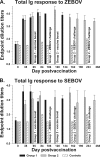Protection of nonhuman primates against two species of Ebola virus infection with a single complex adenovirus vector
- PMID: 20181765
- PMCID: PMC2849326
- DOI: 10.1128/CVI.00467-09
Protection of nonhuman primates against two species of Ebola virus infection with a single complex adenovirus vector
Abstract
Ebola viruses are highly pathogenic viruses that cause outbreaks of hemorrhagic fever in humans and other primates. To meet the need for a vaccine against the several types of Ebola viruses that cause human diseases, we developed a multivalent vaccine candidate (EBO7) that expresses the glycoproteins of Zaire ebolavirus (ZEBOV) and Sudan ebolavirus (SEBOV) in a single complex adenovirus-based vector (CAdVax). We evaluated our vaccine in nonhuman primates against the parenteral and aerosol routes of lethal challenge. EBO7 vaccine provided protection against both Ebola viruses by either route of infection. Significantly, protection against SEBOV given as an aerosol challenge, which has not previously been shown, could be achieved with a boosting vaccination. These results demonstrate the feasibility of creating a robust, multivalent Ebola virus vaccine that would be effective in the event of a natural virus outbreak or biological threat.
Figures




Similar articles
-
Development of a cAdVax-based bivalent ebola virus vaccine that induces immune responses against both the Sudan and Zaire species of Ebola virus.J Virol. 2006 Mar;80(6):2738-46. doi: 10.1128/JVI.80.6.2738-2746.2006. J Virol. 2006. PMID: 16501083 Free PMC article.
-
Vesicular stomatitis virus-based vaccines protect nonhuman primates against Bundibugyo ebolavirus.PLoS Negl Trop Dis. 2013 Dec 19;7(12):e2600. doi: 10.1371/journal.pntd.0002600. eCollection 2013. PLoS Negl Trop Dis. 2013. PMID: 24367715 Free PMC article.
-
Single-injection vaccine protects nonhuman primates against infection with marburg virus and three species of ebola virus.J Virol. 2009 Jul;83(14):7296-304. doi: 10.1128/JVI.00561-09. Epub 2009 Apr 22. J Virol. 2009. PMID: 19386702 Free PMC article.
-
Vaccines against 'the other' Ebolavirus species.Expert Rev Vaccines. 2016 Sep;15(9):1093-100. doi: 10.1586/14760584.2016.1170597. Epub 2016 Apr 12. Expert Rev Vaccines. 2016. PMID: 27010528 Review.
-
Ebola virus vaccines: an overview of current approaches.Expert Rev Vaccines. 2014 Apr;13(4):521-31. doi: 10.1586/14760584.2014.885841. Epub 2014 Feb 27. Expert Rev Vaccines. 2014. PMID: 24575870 Free PMC article. Review.
Cited by
-
Multivalent and Multipathogen Viral Vector Vaccines.Clin Vaccine Immunol. 2017 Jan 5;24(1):e00298-16. doi: 10.1128/CVI.00298-16. Print 2017 Jan. Clin Vaccine Immunol. 2017. PMID: 27535837 Free PMC article. Review.
-
Recombinant vesicular stomatitis virus vaccine vectors expressing filovirus glycoproteins lack neurovirulence in nonhuman primates.PLoS Negl Trop Dis. 2012;6(3):e1567. doi: 10.1371/journal.pntd.0001567. Epub 2012 Mar 20. PLoS Negl Trop Dis. 2012. PMID: 22448291 Free PMC article.
-
Antibody-Mediated Protective Mechanisms Induced by a Trivalent Parainfluenza Virus-Vectored Ebolavirus Vaccine.J Virol. 2019 Feb 5;93(4):e01845-18. doi: 10.1128/JVI.01845-18. Print 2019 Feb 15. J Virol. 2019. PMID: 30518655 Free PMC article.
-
Vaccines for viral hemorrhagic fevers--progress and shortcomings.Curr Opin Virol. 2013 Jun;3(3):343-51. doi: 10.1016/j.coviro.2013.04.007. Epub 2013 Jun 15. Curr Opin Virol. 2013. PMID: 23773330 Free PMC article. Review.
-
Role of homologous recombination/recombineering on human adenovirus genome engineering: Not the only but the most competent solution.Eng Microbiol. 2024 Feb 8;4(1):100140. doi: 10.1016/j.engmic.2024.100140. eCollection 2024 Mar. Eng Microbiol. 2024. PMID: 39628785 Free PMC article. Review.
References
-
- Bermejo, M., J. D. Rodriguez-Teijeiro, G. Illera, A. Barroso, C. Vila, and P. D. Walsh. 2006. Ebola outbreak killed 5000 gorillas. Science 314:1564. - PubMed
-
- Borio, L., T. Inglesby, C. J. Peters, A. L. Schmaljohn, J. M. Hughes, P. B. Jahrling, T. Ksiazek, K. M. Johnson, A. Meyerhoff, T. O'Toole, M. S. Ascher, J. Bartlett, J. G. Breman, E. M. Eitzen, Jr., M. Hamburg, J. Hauer, D. A. Henderson, R. T. Johnson, G. Kwik, M. Layton, S. Lillibridge, G. J. Nabel, M. T. Osterholm, T. M. Perl, P. Russell, and K. Tonat. 2002. Hemorrhagic fever viruses as biological weapons: medical and public health management. JAMA 287:2391-2405. - PubMed
-
- Bray, M. 2003. Defense against filoviruses used as biological weapons. Antiviral Res. 57:53-60. - PubMed
-
- Casimiro, D. R., L. Chen, T. M. Fu, R. K. Evans, M. J. Caulfield, M. E. Davies, A. Tang, M. Chen, L. Huang, V. Harris, D. C. Freed, K. A. Wilson, S. Dubey, D. M. Zhu, D. Nawrocki, H. Mach, R. Troutman, L. Isopi, D. Williams, W. Hurni, Z. Xu, J. G. Smith, S. Wang, X. Liu, L. Guan, R. Long, W. Trigona, G. J. Heidecker, H. C. Perry, N. Persaud, T. J. Toner, Q. Su, X. Liang, R. Youil, M. Chastain, A. J. Bett, D. B. Volkin, E. A. Emini, and J. W. Shiver. 2003. Comparative immunogenicity in rhesus monkeys of DNA plasmid, recombinant vaccinia virus, and replication-defective adenovirus vectors expressing a human immunodeficiency virus type 1 gag gene. J. Virol. 77:6305-6313. - PMC - PubMed
Publication types
MeSH terms
Substances
Grants and funding
LinkOut - more resources
Full Text Sources
Other Literature Sources
Medical

